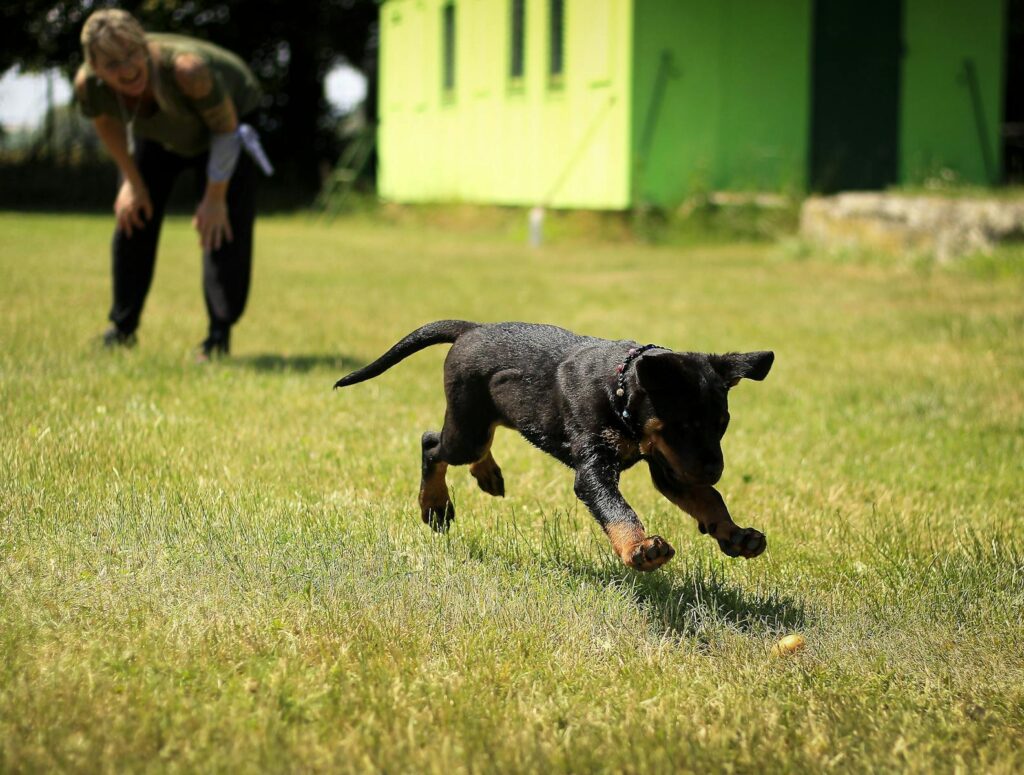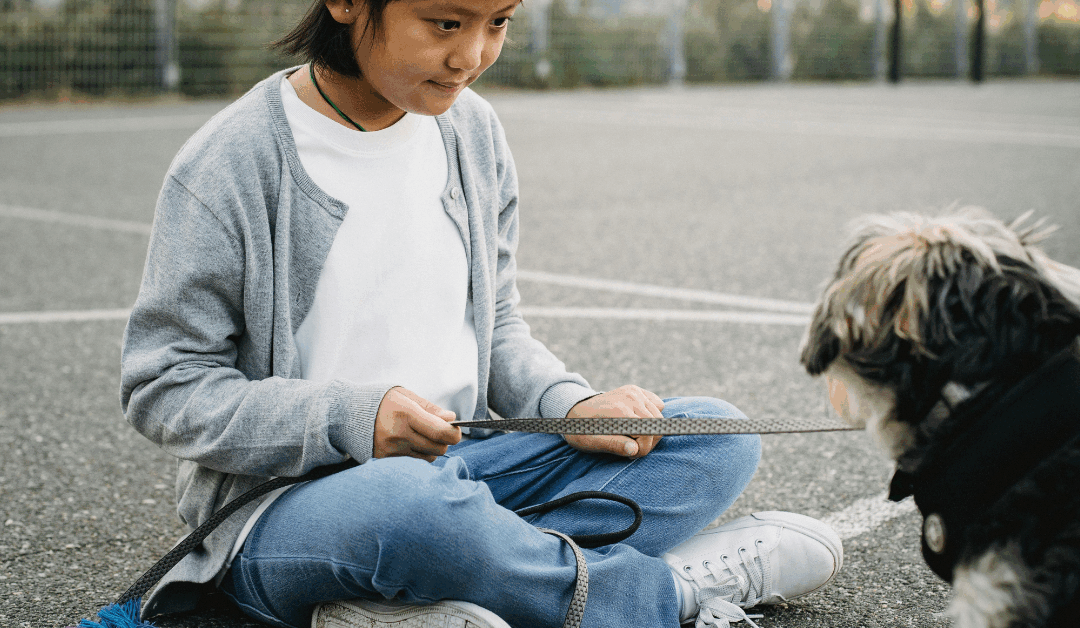Pure positive reinforcement dog training sounds appealing on the surface. After all, who doesn’t want to train their dog using only treats, praise, and rewards? However, experienced dog trainers and animal behaviorists increasingly recognize that balanced training methods—combining both positive and negative punishment—create more reliable, well-adjusted dogs than positive-only approaches.
While positive reinforcement forms the foundation of effective modern dog training, relying exclusively on rewards can leave significant gaps in your dog’s education. Dogs need clear boundaries and consistent communication to thrive, and balanced training provides the complete toolkit necessary for success.

Unlock Real Behavior Change – Download Your Free Guide Now
"*" indicates required fields
I always say, “Life isn’t always just rainbows and unicorns”. If you get hit by a car, that won’t be a pleasant experience. Dogs need to understand that same philosophy. Just because you’re cute, doesn’t mean you don’t need to listen. It doesn’t mean that consequences don’t exist. Don’t put too much human emotion into the dog. That could lead you down a bad path. When push comes to shove, the dog has one thing in mind, “what’s best for ME?!” If you can’t communicate through that and help the dog understand that there are negative incentives as well, the dog WILL run the home.

Photo by Camylla Battani on Unsplash
Understanding Positive and Negative Reinforcement in Dog Training
Before diving into why balanced methods work better, it’s essential to understand what positive and negative reinforcement actually mean in dog training contexts.
Positive reinforcement involves adding something pleasant when your dog performs the desired behavior. This includes food rewards, verbal praise, toys, or physical affection. When your dog sits on command and receives a treat, that’s positive reinforcement in action.
Negative reinforcement removes something unpleasant when your dog displays good behavior. For example, releasing leash pressure the moment your dog stops pulling teaches them that walking nicely beside you eliminates the uncomfortable sensation.
Most people misunderstand negative reinforcement, confusing it with punishment. However, negative reinforcement actually strengthens desired behaviors by removing pressure or discomfort when the dog responds correctly.

Photo by Matt Nelson on Unsplash
The Limitations of Positive-Only Training
Incomplete Communication System
Dogs naturally learn through a combination of pressure and release, rewards and consequences. In the wild, mother dogs use both positive and negative feedback to teach their puppies appropriate behavior. A purely positive approach limits your ability to communicate effectively with your dog.
Consider leash training. Using only treats and praise, you might reward your dog when they walk beside you. However, without the ability to apply gentle leash pressure when they pull, many dogs struggle to understand exactly what behavior you want. The pressure provides clear guidance, while the release confirms they’ve made the correct choice.
Try keeping the leash on the dog and having the dog attached to you, so you can see when they’re about to go and take them out immediately.
Real-World Application Challenges
Pure positive reinforcement often fails in high-distraction environments or emergency situations. When your dog spots a squirrel during a walk, that food reward in your pocket suddenly becomes far less motivating than the exciting chase opportunity ahead.
Balanced training teaches dogs to respond reliably regardless of environmental distractions. A dog that understands both the reward for compliance and the consequence for ignoring commands will make better decisions when it matters most.
Behavioral Gaps with Complex Behaviors
Some behaviors are difficult to teach using positive reinforcement alone. Take the “stay” command as one example. While you can reward your dog for remaining in position, positive-only methods struggle to address the moment when your dog breaks the stay. Without a correction system, dogs often develop inconsistent responses to important commands.
Things To Know About Balanced Training Methods
While balanced training offers numerous advantages, it’s important to acknowledge a few potential drawbacks to provide a fair perspective. First, balanced training requires a high level of skill and understanding to ensure techniques like corrections are applied appropriately and humanely. Without proper knowledge or guidance, there’s a risk of misusing these methods, leading to confusion or stress for the dog. Additionally, some owners may find it challenging to strike the right balance between positive and corrective elements, which can hinder progress.
Lastly, balanced training can sometimes be misinterpreted by those unfamiliar with the approach, particularly those who might view all corrections negatively. This misunderstanding can create unnecessary skepticism or criticism, even when balanced training is being implemented responsibly and with the dog’s best interests in mind. By focusing on education and proper application, these challenges can be effectively mitigated, making balanced training a highly successful and ethical method overall.
Does Balanced Training Create Better Results?
Clearer Communication Through Pressure and Release
Balanced dog training mirrors how dogs naturally learn from each other and their environment. When teaching new commands, gentle pressure guides the dog toward the correct response, while immediate release and rewards confirm success.
This pressure-and-release system creates what trainers call “feel.” Your dog learns to respond to subtle cues and develops a deeper understanding of what you’re asking. The result is more responsive, attentive dogs that work as partners rather than simply performing tricks for treats.
Building a Reliable Response Under Stress
Dogs trained with balanced methods typically show greater reliability when faced with distractions, stress, or emergencies. They’ve learned that compliance isn’t optional based on their mood or the presence of more exciting alternatives.
Professional dog trainers working with service animals, police dogs, and search-and-rescue teams rely heavily on balanced training approaches. These dogs must perform consistently regardless of environmental conditions, and balanced training provides the foundation for such reliability.
Faster Learning and Retention
Many dogs actually learn new skills more quickly with balanced training methods. The combination of positive and negative reinforcement creates multiple pathways for understanding, helping dogs grasp complex concepts faster than positive-only approaches.
The pressure component provides immediate feedback when the dog makes mistakes, while rewards reinforce correct responses. This dual-feedback system accelerates the learning process and improves long-term retention of new behaviors.

Photo by Cookie the Pom on Unsplash
Implementing Balanced Training Effectively
Starting with Positive Reinforcement
Effective balanced training always begins with positive reinforcement. Establish a strong foundation of trust and motivation through rewards before introducing any pressure or corrections. Your dog should eagerly engage in training sessions and view you as a source of good things.
Use high-value food rewards, enthusiastic verbal praise, and play to build your dog’s enthusiasm for training. This positive foundation ensures that any pressure applied later occurs within a context of trust and cooperation.
Introducing Pressure Gradually
When incorporating negative reinforcement, start with the gentlest pressure possible. For leash training, this might mean slight tension that releases immediately when your dog responds. For teaching “sit,” gentle upward pressure on the collar combined with downward pressure on the hindquarters guides the dog into position.
The key principle is using the minimum pressure necessary to communicate your request, then releasing immediately when your dog complies. This teaches your dog that they control the pressure through their responses.
Timing and Consistency
Successful balanced training demands precise timing and absolute consistency. Pressure must be applied at exactly the right moment and released immediately when the dog responds correctly. Similarly, rewards should follow good behavior within seconds to create clear associations.
Most dogs respond best to brief, well-timed corrections followed by immediate praise and rewards when they comply. This combination helps dogs understand both what you don’t want and what you do want from them.
Common Misconceptions About Balanced Training
“Balanced Training Is Harsh or Outdated Compared To Positive Reinforcement Training Only”
Modern balanced training bears little resemblance to old-fashioned dominance-based methods. Today’s balanced trainers emphasize clear communication, relationship-building, and humane techniques that respect the dog’s emotional well-being.
The pressure used in balanced training is typically minimal—just enough to get the dog’s attention and guide them toward the correct response. Professional trainers spend considerable time learning proper technique to ensure they apply pressure appropriately and humanely.
“Dogs Trained with Negative Punishment Or Corrections Become Fearful”
When applied correctly, balanced training actually builds confidence in dogs. They learn to trust their handler’s guidance and develop a clear understanding of expectations. Dogs trained with appropriate pressure and release often display more confidence and enthusiasm than those trained with confusing or inconsistent methods.
Fear-based responses typically result from improper technique, excessive corrections, or lack of positive reinforcement—not from balanced training itself. Well-executed balanced training creates eager, responsive dogs that enjoy working with their handlers.
“Positive-Only Training Is More Humane”
While positive-only training avoids direct corrections, it can create its own welfare concerns. Dogs that never learn clear boundaries may experience chronic stress from uncertainty about expectations. Additionally, dogs that don’t respond reliably to commands face greater risks in dangerous situations.
Humane training focuses on effective communication and the dog’s overall well-being, not simply avoiding all forms of pressure or correction. Many dogs actually prefer the clarity that balanced training provides.
Let’s put this into perspective. If you were never taught that bad things can result from your actions, what would keep you from committing crimes or behaving in a “humane” manner? The word “humane” has HUMAN in it, which the dog is NOT. The dog is not a human. Again, I want to reiterate to stop putting human emotions into the dog. Establish that connection with the dog by creating clarity in your communication; no means no. What exactly does “no” mean? That’s up to you to reinforce what consequence that brings. Most just shout “no” with nothing to aid the dog in understanding what that means. “AJDFIOAHSE” if I don’t help you understand what I just wrote, you’re going to have a difficult time communicating and establishing a connection with me. It’s the same for the dog. You don’t know what sentences he’s saying when he’s barking, just as he doesn’t know what you’re saying.
Choosing the Right Training Approach for Your Dog
Assessing Your Dog’s Personality and Needs
Some dogs naturally respond well to positive-only methods, particularly sensitive or soft-tempered animals. However, many dogs—especially confident, independent, or high-energy breeds—benefit significantly from the structure and clarity that balanced training provides.
Consider your dog’s temperament, age, and training goals when selecting an approach. Puppies typically start with primarily positive methods, gradually incorporating gentle guidance as they mature. Adult dogs with established behavioral issues often need the comprehensive communication system that balanced training offers.

Working with Professional Trainers At Ruff House Dog Training
Balanced training requires proper technique and timing to be effective and humane. Working with Ruff House Dog training can ensure you learn appropriate methods and avoid common mistakes that can undermine training progress.
At Ruff House Training, they emphasize relationship-building, use modern balanced techniques, and can demonstrate their methods clearly. Professional guidance becomes especially important when addressing serious behavioral issues or training working dogs. Contact us to create a custom training program for your dog today!
Making Balanced Training Work in Your Daily Life
Consistency Across Family Members
Successful balanced training requires all family members to apply the same techniques consistently. Dogs quickly learn to test different people if they sense inconsistency in expectations or responses.
Spend time teaching all family members proper technique and ensure everyone understands the training protocols. This consistency helps your dog generalize their training across different contexts and handlers.
Adapting Techniques for Different Situations
Balanced training provides flexibility to adjust your approach based on the specific situation and your dog’s response. In low-distraction environments, minimal pressure might be sufficient. High-distraction scenarios may require clearer guidance to maintain your dog’s attention and compliance.
Learn to read your dog’s body language and adjust your techniques accordingly. Some dogs need more encouragement and rewards, while others respond better to clearer boundaries and guidance.
The Science Behind Balanced Approaches
How Dogs Learn Naturally
Research in canine cognition shows that dogs learn most effectively through multiple feedback systems. Wild canids use combinations of positive and negative experiences to navigate their environment and social relationships.
Balanced training aligns with these natural learning patterns, creating training experiences that make sense to dogs. This alignment often results in faster learning and better retention compared to methods that rely on only one type of feedback.
Neurological Benefits of Varied Feedback
Studies suggest that training methods incorporating multiple types of feedback can enhance neuroplasticity and learning capacity in dogs. The combination of pressure, release, and rewards activates different neural pathways, potentially strengthening the overall learning experience.
This neurological complexity may explain why many dogs trained with balanced methods show superior problem-solving abilities and adaptability compared to those trained with more limited approaches.
Helpful Resource
For those seeking to learn more about balanced dog training, the following website and resource can provide valuable information:
- The International Association of Canine Professionals (IACP) is a professional organization dedicated to advancing the highest standards of professional and humane dog training techniques, including balanced training.
Building Long-Term Success With Balanced Training That Includes Positive Reinforcement Dog Training
Balanced dog training isn’t just about teaching commands—it’s about building a communication system that strengthens your relationship with your dog throughout their lifetime. Dogs trained with balanced methods often display greater confidence, better impulse control, and stronger bonds with their handlers.
The key to success lies in maintaining the balance between training positively reinforced behavior and appropriate guidance. Your dog should view training as an enjoyable partnership where clear communication leads to mutual satisfaction and success.
Remember that effective dog training is ultimately about creating a well-adjusted companion who can navigate the world confidently alongside you. Balanced training methods provide the comprehensive toolkit necessary to achieve this goal, combining the motivating power of positive reinforcement with the clarity and structure that negative reinforcement provides.
Whether you’re teaching basic obedience, addressing behavioral issues, or training for specific tasks, balanced approaches offer the flexibility and effectiveness that purely positive dog training methods often lack. The result is a training experience that respects your dog’s natural learning patterns while building the reliable responses necessary for a harmonious life together.












